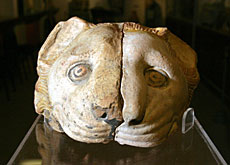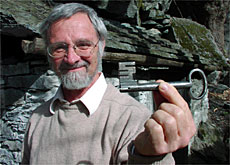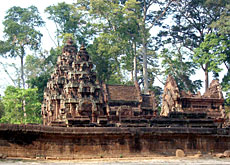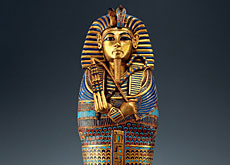Restored lion’s head is museum’s mane attraction

Two halves of a rare terracotta lion’s head dating from 5BC have been reunited thanks to a Swiss art collector after spending centuries apart.
The lion’s head waterspout is thought to have once graced a temple built by Greek colonists in southern Italy and probably broke in two when the building collapsed.
The right half was bought by British collector Lionel Jacobson and donated to the Shefton Museum at Newcastle University, England.
The other half ended up in the private ancient art collection of Dr Leo Mildenberg of Zurich, who bequeathed it to the museum in 2001.
The two halves were finally joined together earlier this year, and the restored sculpture is now attracting the lion’s share of attention at the Shefton Museum of Greek Art and Archaeology.
Professor Brian Shefton, the museum’s founder, told swissinfo that a series of coincidences had played a major role in the happy outcome.
He first learned of the existence of the other half of the lion’s head in the early 1970s while flicking through the catalogue of a University of Zurich exhibition of animals in ancient art.
Good fit
Later when the Mildenberg collection went on show in the United States, the emeritus professor of classical archaeology contacted a curator in Cleveland, and asked for a plaster cast of the broken edge of the Swiss lion.
“I remember we had a classical archaeology class on the day when it arrived, so I assembled everybody and went to our museum, took out our piece and fitted the cast onto it,” recalled Shefton.
“The fit showed that it belonged.”
But the two halves were not identical. Differences in sediment build-up showed they had been apart for a long time – possibly centuries – and stored under different conditions.
“They looked very different because they were conserved in different ways,” Shefton told swissinfo. “Some of the details of the face are preserved better on the Mildenberg half.”
On the Swiss half of the head, fragments of original decoration – the eye and whiskers – are still clearly visible, while on the Newcastle half less paint remains and the overall colour is paler.
Long wait
But after establishing that the two halves belonged together, the Shefton Museum had to wait another quarter of a century before it could see them reunited. Three years after Mildenberg’s death, his share of the lion was finally passed to Newcastle, in accordance with his wishes.
As far as Shefton is concerned, it was worth the wait.
“There are many [lions heads], but ours is very true to nature and ranks among the best,” said the professor.
“Now that the two bits are together you see it frontally for the first time and it is a very fine piece.
“There’s been a great increase in the number of people coming to look at it.”
swissinfo, Morven McLean
The two halves of the lion’s head formed a waterspout adorning a 5BC Greek temple in southern Italy.
They were probably separated when the temple collapsed.
One half was bought by British collector Lionel Jacobson and donated to the Shefton Museum of Greek Art and Archaeology at the University of Newcastle, England.
The other half ended up in the collection of Dr Leo Mildenberg, a Swiss collector of ancient art.
Mildenberg, who worked at Zurich’s Bank Leu, donated his share to the Shefton Museum on his death in 2001.
Shefton Museum founder Brian Shefton is emeritus professor of classical archaeology at Newcastle University.

In compliance with the JTI standards
More: SWI swissinfo.ch certified by the Journalism Trust Initiative



You can find an overview of ongoing debates with our journalists here . Please join us!
If you want to start a conversation about a topic raised in this article or want to report factual errors, email us at english@swissinfo.ch.